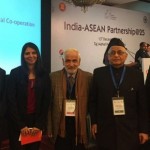Key points in the presentation give by Ambassador Rajiv Bhatia, Distinguished Fellow, Gateway House, Mumbai at the Conference on India-ASEAN Partnership@25, New Delhi for the third session on ‘Regional and Bilateral Co-operation’. Read more about the event here.
- On India-ASEAN partnership@25, a quick look at the rear mirror helps us to situate where we are coming from as well as to focus on where we plan to move ahead.
- In 1992, ASEAN was still a regional grouping of only six nations. Some of its great achievements – the Charter, the complex web of inter-state institutions centering around it, the commitment to become a single Community with three pillars – were still in the womb of the future.
- India then was at the starting point of its journey of economic liberalisation. A quarter century later, it reaps the benefits as a fast-growing emerging economy which is aware that it has many more peaks to scale in the future.
- Our assessment of the partnership is necessarily shaped by our view of ASEAN’s balance sheet in the past five decades. On this, opinion is divided in the community of our experts. Some consider it as a great success worthy to be emulated; others point to its under-performance and failings. There is even a view that, with the changed or changing US-China power equation in East Asia, ASEAN faces ‘a serious existentialist crisis.’
- Overall, I hold a positive and optimistic view. As a regional cooperation project that has brought economic growth and better political-cultural relations among its member-states, ASEAN has been a considerable success. It withstood a cold war, several military conflicts and economic crises. This showed its inner strength and resilience. As the architect of the famous “ASEAN Way” with its stress on the formula of three Cs – Consultation, Compromise and Consensus, ASEAN has contributed positively to the management of regional relations.
- However, it has still a long way to go to secure equality, engagement with people, and integration between the original and new members. Besides, its unity and centrality on a number of important issues (such as the South China Sea and Rohingya crisis) are under serious stress.
- Now, looking ahead, I shall venture to suggest that India should adopt the “ASEAN Plus Policy”. In my reckoning, it will have the three following facets:
Intensify cooperation with ASEAN through both the regional track and the bilateral track:
- On the regional track, consider afresh the obstacles that hamper trade and investment expansion; accelerate RCEP negotiations; make the utilisation of three Funds more effective and better known; and produce results from the two initiatives announced by the Modi government – $1 billion for digital connectivity with ASEAN countries and $75 million for new projects in the CMLV region. While doing all this, let us accord a high priority to the development needs of our Northeast.
- On the bilateral track, focus on deepening ties with select countries such as Indonesia, Vietnam, Singapore, Malaysia and Myanmar.
Plan a step-by-step rejuvenation and expansion of BIMSTEC:
- Shortlist a few priority areas for cooperation
- Initiate institutional reforms
- Set up a BIMSTEC Development Fund
- Invite Vietnam, Cambodia and Lao PDR into the grouping. When the BIMSTEC membership goes up from 7 to 10, it will reflect a better balance between South Asia and Southeast Asia.
- Within the expanded BIMSTEC, keep strengthening BBIN as the core, and leverage its progressive integration to drive BIMSTEC forward.
Address the changing power dynamics in East Asia through the strategy of vigilance and resilience:
- We all want a stable secure and prosperous East Asia, but not all of us – ‘the China-wary nations’ – would accept a Sino-centric Asia. Regional unity should be built around multi-polarity and smart balance. This alone will be the bulwark for regional stability.
- While avoiding the perils of military confrontation and Cold War-type containment, India should be pro-active in the further development of and harmonization within the Quadrilateral Grouping or Quad of US, Japan, Australia and India. But this will not be enough.
- Developing the Quad’s strategic communication and links with other nations – Indonesia, Vietnam, Singapore, Myanmar and South Korea – should be an immediate goal, and
- India’s Act East Policy should operate within the larger Indo-Pacific framework.
Rajiv Bhatia is Distinguished Fellow, Foreign Policy Studies, Gateway House
You can read exclusive content from Gateway House: Indian Council on Global Relations, here.
For interview requests with the author, or for permission to republish, please contact outreach@gatewayhouse.in.
© Copyright 2017 Gateway House: Indian Council on Global Relations. All rights reserved. Any unauthorized copying or reproduction is strictly prohibited


